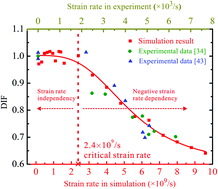A nanoscale study of the negative strain rate dependency of the strength of metallic glasses by molecular dynamics simulations
Abstract
Compressive strength and deformation characteristics of a metallic glassy alloy related to strain rate are studied by molecular dynamics simulations. The negative strain rate dependency of strength is presented, i.e., compressive strength decreases with the increase of strain rate, which is well in line with the experimental results. The negative strain rate dependency of strength is explained from two aspects at the atomic scale of free volume and potential energy. Compressive strength is related to the free volume formation in a shear band, which is different from that in a metallic glass matrix. In addition, the relation of potential energy and temperature is also investigated, which indicates that thermal softening also plays an important role in the negative strain rate dependency of strength. The thermal–mechanical coupling mechanisms causing the negative strain rate dependency of the strength of the metallic glassy alloy are clarified. It is significant to explore the intrinsic deformation characteristics of the metallic glassy alloy under a high rate loading.



 Please wait while we load your content...
Please wait while we load your content...